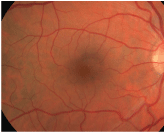 Q: A 76-year-old male glaucoma patient developed cataracts and had surgery. When I saw him one month post-op, he complained of blurred vision and had cystoid macular edema (CME). I stopped the glaucoma drop and his vision eventually returned to normal. Shouldnt we discontinue prostaglandins in all patients about to undergo cataract surgery?
Q: A 76-year-old male glaucoma patient developed cataracts and had surgery. When I saw him one month post-op, he complained of blurred vision and had cystoid macular edema (CME). I stopped the glaucoma drop and his vision eventually returned to normal. Shouldnt we discontinue prostaglandins in all patients about to undergo cataract surgery?
A: Not in all cataract patients, but certainly those at high risk for CME, says Robert Pinkert, O.D., medical director of the
High-risk patients, he says, include those with a previous history of CME in the contralateral eye following uncomplicated cataract extraction. In these patients, Dr. Pinkert discontinues the prostaglandin a week before surgery.
Other high-risk patients are those who had breach of the posterior capsule with anterior vitrectomy during cataract extraction. For these patients, Dr. Pinkert discontinues the prostaglandin immediately after surgery.
In both cases, he resumes it four to six weeks post-op, as long as no CME develops.
But why discontinue prostaglandins only in high-risk patients, and not all patients? The risk of [visually-significant] postoperative CME is extremely low, if it exists at all, in uncomplicated cataract extraction due to the use of prostaglandin analogs, Dr. Pinkert says.1
Still, the jury is out on how prostaglandin analogs cause CME, or whether they do at all. Until the link is determined, some doctors take a more conservative approach.
Misdiagnosed six times, this patient was found to have cystoid macular edema.
For one, Trennda Rittenbach, O.D., in private practice near

Photo courtesy: Trennda Rittenbach, O.D.
For patients at high risk for CMEthose with a history of diabetes, retinal vascular disease, epiretinal membrane, uveitis or aphakiaI wait six weeks until switching them back to the prostaglandin, Dr. Rittenbach says.2,3
Prostaglandins, products of the arachadonic acid cascade, are thought to cause a breakdown of the blood-retina barrier, which contributes to the development of CME, she says.4 Because prostaglandin analogs are thought to work primarily through binding to the prostaglandin F receptor, many researchers suggest that this must be the mechanism of postoperative CME in patients using these medications.5
There are, of course, other causes of macular edema after cataract surgery. Be sure to take a careful history to be sure the patient is complying with his or her post-op med regimen. Clinically, look for residual cortex with chronic uveitis that can lead to the synthesis of prostaglandin E2 and cytokines, Dr. Rittenbach says. These mediators likely lead to the breakdown of the blood-aqueous barrier and resultant CME.6 Aggressive and timely management with topical steroids and non-steroidal anti-inflammatory drops is critical in these cases.
Based on what I have seen, I will continue to take the conservative route when managing my glaucoma patients by stopping prostaglandin medications prior to their undergoing cataract extraction, she says.
1. Lima MC, Paranhos A Jr, Salim S, et al. Visually significant cystoid macular edema in pseudophakic and aphakic patients with glaucoma receiving latanoprost. J Glaucoma 2000 Aug;9(4):317-21.
2. Wand M,
3. Henderson BA, Kim JY, Ament CS, et al. Clinical pseudophakic cystoids macular edema: Risk factors for development and duration after treatment. J Cataract Refract Surg 2007 Sep;33(9):1550-8.
4. Miyake K, Ibaraki N. Prostaglandins and cystoid macular edema. Surv Ophthalmol 2002 Aug;47(Suppl 1):S203-18.
5. Toris CB, Zhan GL, Feilmeier MR, et al. Effects of a prostaglandin DP receptor agonist, AL-6598, on aqueous humor dynamics in a nonhuman primate model of glaucoma. J Ocul Pharmacol Ther 2006 Apr;22(2):86-92.
6. Nishi O, Nishi K, Imanishi M. Synthesis of interleukin-1 and prostaglandin E2 by lens epithelial cells of human cataracts. Br J Ophthalmol 1992 Jun;76(6):338-41.

